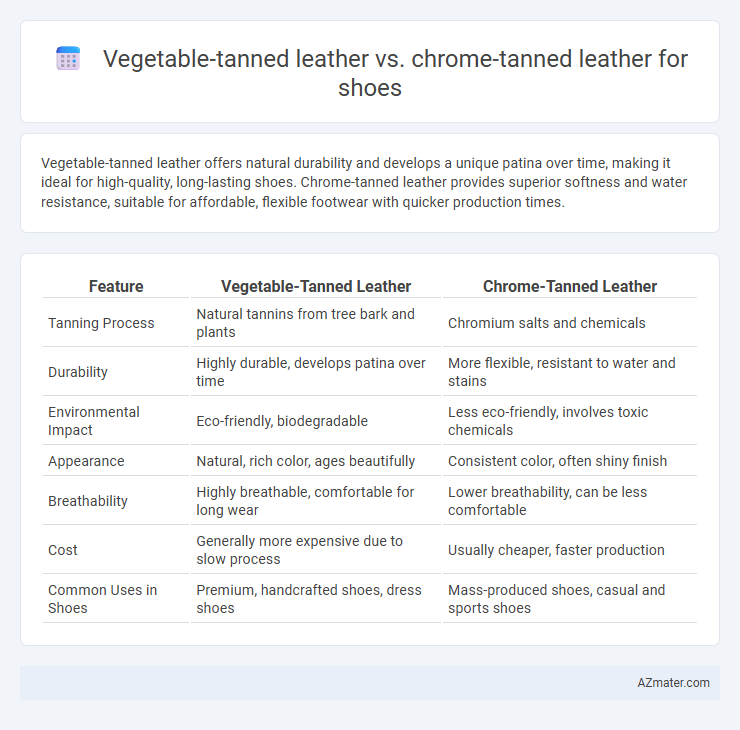Vegetable-tanned leather offers natural durability and develops a unique patina over time, making it ideal for high-quality, long-lasting shoes. Chrome-tanned leather provides superior softness and water resistance, suitable for affordable, flexible footwear with quicker production times.
Table of Comparison
| Feature | Vegetable-Tanned Leather | Chrome-Tanned Leather |
|---|---|---|
| Tanning Process | Natural tannins from tree bark and plants | Chromium salts and chemicals |
| Durability | Highly durable, develops patina over time | More flexible, resistant to water and stains |
| Environmental Impact | Eco-friendly, biodegradable | Less eco-friendly, involves toxic chemicals |
| Appearance | Natural, rich color, ages beautifully | Consistent color, often shiny finish |
| Breathability | Highly breathable, comfortable for long wear | Lower breathability, can be less comfortable |
| Cost | Generally more expensive due to slow process | Usually cheaper, faster production |
| Common Uses in Shoes | Premium, handcrafted shoes, dress shoes | Mass-produced shoes, casual and sports shoes |
Introduction to Leather Tanning Methods
Vegetable-tanned leather utilizes natural tannins from tree bark and plants, resulting in a durable, eco-friendly material favored for high-quality shoe craftsmanship due to its firm texture and unique aging properties. Chrome-tanned leather, processed with chromium salts, offers greater softness, water resistance, and faster production, making it popular in mass-produced footwear. The choice between these tanning methods impacts shoe durability, appearance, and environmental footprint significantly.
What is Vegetable-Tanned Leather?
Vegetable-tanned leather is a natural tanning method that uses organic tannins found in tree bark, leaves, and fruits to preserve and strengthen the hide, resulting in a durable and eco-friendly material. This type of leather develops a rich patina over time, enhancing its aesthetic appeal and making it ideal for high-quality, long-lasting shoes. Unlike chrome-tanned leather, vegetable-tanned leather is free from heavy metals and chemicals, promoting better breathability and environmental sustainability.
What is Chrome-Tanned Leather?
Chrome-tanned leather is leather treated with chromium salts, primarily chromium sulfate, resulting in a softer, more flexible, and water-resistant material compared to vegetable-tanned leather. This tanning method significantly reduces processing time, often completing in a day, making it widely used in shoe manufacturing for its durability and color retention. Despite its advantages, chrome-tanned leather may have less natural breathability and can be less eco-friendly due to the chemicals involved in the tanning process.
Key Differences in Tanning Processes
Vegetable-tanned leather undergoes a natural tanning process using plant-based tannins derived from bark, leaves, and fruits, resulting in a firmer, more breathable material with a distinct aroma. Chrome-tanned leather uses chromium salts in a chemical tanning method that provides faster production, enhanced softness, and greater water resistance but may have environmental drawbacks. The key differences lie in processing time, environmental impact, durability, and the leather's final texture, influencing shoe quality and longevity.
Durability and Performance Comparison
Vegetable-tanned leather exhibits superior durability with increased resistance to wear and natural aging, making it ideal for high-quality, long-lasting shoes. Chrome-tanned leather offers enhanced water resistance and greater flexibility, contributing to better performance in wet conditions and faster break-in periods. While vegetable-tanned leather develops a unique patina over time, chrome-tanned leather generally maintains consistent appearance and structure under frequent use.
Environmental Impact of Each Tanning Method
Vegetable-tanned leather relies on natural tannins from plant sources, resulting in biodegradable and less toxic waste, making it more environmentally friendly compared to chrome-tanned leather. Chrome-tanned leather uses chromium salts, which can release harmful pollutants and heavy metals during production and disposal, posing significant environmental hazards. The slower processing time and natural materials in vegetable tanning significantly reduce the ecological footprint of leather shoe manufacturing.
Comfort and Wearability in Footwear
Vegetable-tanned leather offers superior breathability and molds naturally to the foot, enhancing comfort and long-term wearability in footwear. Chrome-tanned leather is more water-resistant and flexible immediately but may retain heat and cause discomfort over extended use. Shoes crafted from vegetable-tanned leather develop a unique patina and maintain structural integrity better with prolonged wear, making them ideal for high-quality, durable footwear.
Aesthetic Qualities and Aging Effects
Vegetable-tanned leather offers a rich, natural patina that deepens and develops unique character with age, enhancing the aesthetic appeal of shoes over time. Chrome-tanned leather maintains a consistent color and texture, providing a smoother and more uniform appearance but often lacks the distinct aging qualities found in vegetable tanning. The slow oxidation process in vegetable-tanned leather creates aesthetically pleasing variations, while chrome tanning emphasizes durability and colorfastness, resulting in less pronounced aging effects.
Cost and Market Availability
Vegetable-tanned leather for shoes typically costs more due to its labor-intensive process and longer curing time, making it less widely available than chrome-tanned leather. Chrome-tanned leather dominates the market because of its faster production and lower price, offering increased accessibility for manufacturers and consumers. The higher cost of vegetable-tanned leather is offset by its eco-friendly qualities and durability, appealing to niche markets focused on sustainability.
Choosing the Right Leather for Your Shoes
Vegetable-tanned leather offers durability, breathability, and a natural aging process, making it ideal for high-quality shoes that develop character over time. Chrome-tanned leather provides flexibility, water resistance, and a more affordable option, suitable for everyday wear and varied weather conditions. Selecting the right leather depends on prioritizing longevity and natural appeal with vegetable tanning or opting for practicality and cost-efficiency with chrome tanning.

Infographic: Vegetable-tanned leather vs Chrome-tanned leather for Shoe
 azmater.com
azmater.com